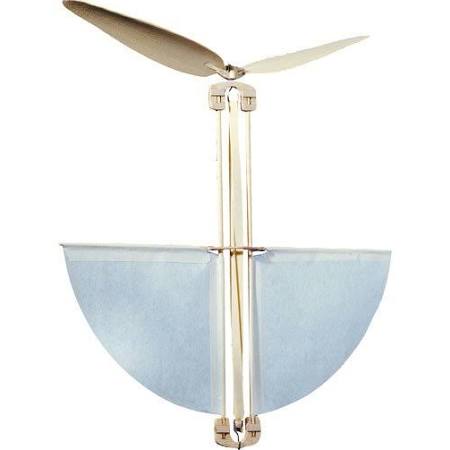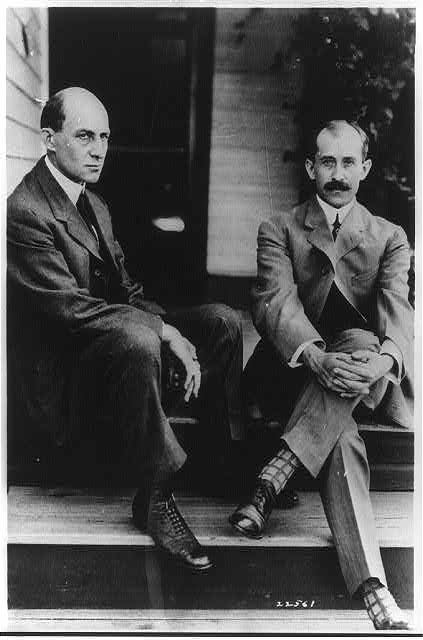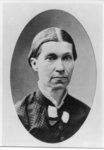Bishop Milton Wright loved to bring toys home from his long church business trips. Typically, he’d look for something that would inspire his childrens’ imaginations, such as an interesting rock or a fossil. But one day, Bishop Wright arrived at home with a particularly interesting toy: a rubber band helicopter his two sons, Wilbur and Orville dubbed, “the bat.” No one knew at the time, but Orville eventually identified that single toy as the inspiration for the Wright Brothers’ interest in the problem of flight.

“We built a number of copies of this toy,” said Orville, “which flew successfully. By ‘we’ I refer to my brother Wilbur and myself. But when we undertook to build the toy on a much larger scale it failed to work so well. The reason for this was not understood by us at the time, so we finally abandoned the experiments.”
Eventually, the question of why the toy failed to work when they tried to make it bigger drove the brothers to study aeronautics more thoroughly.
“In the spring of the year 1899 our interest in the subject was again aroused through the reading of a book on ornithology. We could not understand that there was anything about a bird that would enable it to fly that could not be built on a larger scale and used by man,” Orville said.
The question that had been inspired by a small toy eventually resulted in a lifetime of study, tinkering, building and experimenting that climaxed with the Wright brothers’ success as aviators.

The Wright Brothers Never Outgrew the Love of Playing
We learn from David McCullough’s biography, The Wright Brothers, that Wilbur and Orville never really outgrew playing, particularly when there were children in the house.
“Their niece Ivonette would say of Orville in particular that he never seemed to tire of playing with them, and that if he ran out of games, he would make candy for them. Wilbur, too, would amuse them in equally wholehearted fashion, though not for long. ‘If we happened to be sitting on his lap, he would straighten out his long legs and we would slide off.’ “
This signaled that it was time for the children to find another source of amusement.
“When we were old enough to get toys, Uncle Orv and Uncle Will had a habit of playing with them until they were broken, then repair them so that they were better than when they were bought.”
Special Advantages: Two Parents Who Encouraged Play

This devotion to toys and play helped shape the successes they would achieve later in life, and their appreciation for play and inquisitiveness seems to have been inspired largely by their parents. Susan Wright, their mother, was described as highly intelligent and affectionate although she was also very shy. As the daughter of a master craftsman, she was known for her mechanical genius, and encouraged her sons to build and tinker. Katherine, a sister to Orville and Wilbur, wrote that Susan would carefully preserve every last one of their projects by picking them up and storing them on a kitchen shelf, rather than disposing of experiments that had been abandoned. And as already mentioned, Bishop Wright strongly encouraged curiosity, especially reading, and was known to allow the children to skip a day of school if they were working on some special project at home.
Orville once observed that the two of them had enjoyed “special advantages…we were lucky enough to grow up in a home environment where there was always much encouragement to children to pursue intellectual interests; to investigate whatever aroused their curiosity.”
Playing with the Box: How a Cardboard Inner Tube Box Inspired Biplane Design
As an example of how this ability to play informed their work, Wilbur told the story of how he was playing with a bicycle inner tube box one afternoon in the bicycle shop the two men ran together. As he chatted with a customer, he squeezed at opposite corners of the box, causing the entire box to change shape. He realized that this “elegant solution” was the answer for how to “warp” the wings of a biplane without breaking them, thus allowing for control of an airplane–something that had eluded inventors who had worked for centuries to solve the problem.
If we are taking a lesson from Milton and Susan Wright in how to raise children who are capable of making special contributions to society, the recipe for giving them “Special Advantages” might look something like this:
- Raise a child in a two-parent home if at all possible.
- Encourage their curiosity with small toys or articles that will encourage mechanical experimentation and curiosity
- Value their projects as useful, not as a nuisance to be discarded
- Allow your children’s intellectual pursuits to periodically take priority over other obligations
- Provide a wide variety of reading material in your home
Indeed, Wilbur Wright probably said it best himself:
“If I were giving a young man advice as to how he might succeed in life, I would say to him, pick out a good father and mother, and begin life in Ohio.”
It sounds like a recipe for success where even the sky is no limit.
Sources:
“An Unusual Childhood.” Wrightbrothers.org. Accessed March 30, 2017. http://www.wright-brothers.org/History_Wing/Wright_Story/Unusual_Childhood/Unusual_Childhood_Intro.htm.
“Inner Tube Box Experiment.: Wrightbrothers.org. Accessed March 30, 2017. http://www.wright-brothers.org/Adventure_Wing/Workshop/Box_Experiment/Box_Experiment.htm
McCullough, David. The Wright Brothers. Simon and Schuster, 2015.
